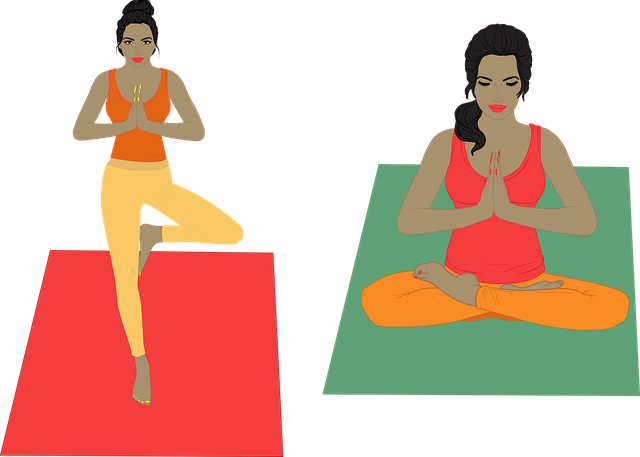Intermittent fasting (IF) is an approach that focuses on eating time, separating it into fasting and eating windows. IF has gained popularity due to its benefits, such as optimal fat burning and a boosted metabolism.
If you’re new to Intermittent Fasting, there’s no need to worry. I’m here to guide you through this journey. We’ll start with a comprehensive 101 Guide to Intermittent Fasting, which I’ve prepared for you here.
Combining fasting with exercise has additional benefits that you should consider to help you achieve your health goals.
One such exercise that you might not have considered is yoga. The unique benefits of combining yoga with IF are worth exploring. Let me explain why this combination could benefit you due to their compatibility.
But before we delve into that, it’s crucial to understand the practice of yoga, especially for those who are not as familiar with it.
Practicing Yoga: Reviewing The Benefits
So, what do you practice when you practice yoga? Yoga, meaning union, has existed since ancient times and focuses on overall well-being, including physical, mental, and spiritual health.
Yoga involves various postures ( aka asanas), controlled breathing exercises (aka pranayamas), meditation, and mindfulness. It has numerous benefits, including improved flexibility, stress reduction, mental clarity, and balance.
Research has also found that yoga can help improve risk factors for heart disease, such as blood pressure, lipid profile, and A1c.
Yoga alone might not improve cardiac health or other exercise goals, such as building muscle mass. For some people, it might not be beneficial for yoga to be their only exercise. But anything you can consistently stick to is better than nothing, so if you want to make yoga your only exercise, you can.
When starting yoga, remember to respect your body’s limits and not push yourself beyond what feels comfortable. Like intermittent fasting, yoga is a personal journey with no competition.
Can You Fast and Practice Yoga? Exploring the Possibilities

To understand the synergy between Intermittent Fasting and yoga, you must understand the compatibility of IF and exercise. Are there any benefits?
Yes, as there is evidence that exercising while fasting boosts metabolism and burns fats more effectively. Research has also shown that fasting does not significantly impact muscle mass and should not result in a loss.
Combining intermittent fasting and yoga offers many positive opportunities and benefits, including enhanced detoxification. IF triggers a cellular process called autophagy, which involves the removal of damaged cells and cellular components. Some research suggests that certain yoga practices, such as twisting poses and inversions, may also influence metabolic processes such as autophagy. Combining yoga with intermittent fasting may further enhance this cellular cleansing process, promoting cellular health and longevity.
IF and yoga can both improve digestion. Combining the two can lead to an even more enhanced effect. Intermittent Fasting can improve digestion by improving the balanced relationship of gut bacteria in the digestive system. Yoga poses that involve twisting and gentle compression of the abdomen can support digestion and alleviate bloating and discomfort. Practicing yoga during fasting may enhance these benefits, allowing your digestive system to rest and reset while not eating.
Beyond these benefits, adding yoga to your intermittent fasting routine contributes to the mindful eating approach, which is essential. This is because yoga strongly encourages mindfulness and becoming more aware of your body. Practicing yoga during fasting can deepen this mind-body connection, allowing you to tune into your body’s signals and sensations more acutely. Being mindful of what you eat and drink should be part of that.
While it is beneficial to combine IF and yoga, it’s important to keep in mind a few safety precautions:
- Listen To Your Body: Fasting can affect individuals differently, so listening to your body and adjusting your yoga practice is essential. If you’re feeling lightheaded, weak, or sleepy, consider modifying your practice or breaking your fast if necessary.
- Stay Hydrated: It’s crucial to stay hydrated during IF, even more so if you add yoga. Drink plenty of water during your eating window, and consider hydrating with water or herbal tea before and after your yoga practice.
- Think About Your Timing: If you practice yoga in the morning, you might find it beneficial to schedule your yoga session during your eating window. This can help ensure you have enough energy for your practice and stay hydrated. Alternatively, you can practice yoga during fasting, but be mindful of your energy levels and hydration.
- Think About Intensity: Pay attention to the intensity and duration of your yoga practice while fasting. If you’re doing a vigorous or strenuous practice, you may need to adjust your intensity or duration to accommodate the lower energy levels that can accompany fasting.
This reassurance about the safety and potential benefits of this combination can help you feel secure and confident in your health choices.
Tailoring Your Yoga Routine to Complement Intermittent Fasting
When tailoring your yoga routine to complement Intermittent Fasting, consider the tips mentioned in the previous section, such as considering timing and intensity.
If you plan on practicing yoga during your fasting window, consider selecting suitable and sustainable styles and asanas. It is essential to choose practices that support your energy levels, promote relaxation, and focus on gentle movement and breath awareness.
Here are some specific yoga practices that are very suitable to consider during your fasting window or close to it:
- Restorative Yoga: Restorative yoga focuses on relaxation and rejuvenation, making it an excellent choice for practicing during fasting periods. Poses are held for longer durations and supported by props such as bolsters and blankets, allowing the body to release tension and promote deep relaxation.
- Yin Yoga: Yin yoga involves holding passive poses for extended periods, targeting the connective tissues, and promoting flexibility and relaxation. Yin poses are often practiced close to the ground and can be adapted to suit individual needs and energy levels during fasting.
- Gentle Yoga: Gentle yoga classes or sequences emphasize slow, mindful movement and breath awareness, making them well-suited for practicing while fasting. These practices promote relaxation, ease tension, and foster a sense of inner calm.
- Breath-Centered Practices: Pranayama, or yogic breathing techniques, can be practiced during fasting periods to support relaxation and energy conservation. Techniques such as deep belly breathing, alternate nostril breathing (Nadi Shodhana), and extended exhalation (Sitali Pranayama) can help calm the nervous system and promote balance and stability.
- Meditation and Mindfulness: Meditation practices, including mindfulness meditation, loving-kindness meditation, and guided visualization, can be incorporated into your yoga practice during fasting periods. These practices promote mental clarity, emotional well-being, and inner peace, regardless of your energy levels.
- Yoga Nidra: Yoga Nidra, or yogic sleep, is a guided relaxation practice that induces deep relaxation and conscious awareness. Practiced lying down in Savasana, Yoga Nidra can help alleviate stress, promote restful sleep, and support overall well-being during fasting.
- Gentle Movement Sequences: Simple, gentle movement sequences that focus on mobilizing the spine, stretching the muscles, and promoting circulation can be practiced during fasting. These sequences can include gentle twists, side stretches, and forward folds, performed mindfully and without strain.
If you are new to yoga, focusing on suitable and sustainable yoga practices is even more critical. You want to remain safe and avoid overexertion.
Here are some beginner-friendly yoga poses to consider that are also good during fasting:
- Child’s Pose (Balasana): This is an excellent choice during fasting as it promotes relaxation and helps calm the mind. It gently stretches the back, hips, and shoulders without significant energy expenditure.
- Cat-Cow Pose (Marjaryasana-Bitilasana): A gentle warm-up mobilizes the spine and promotes breath awareness. It can be practiced slowly and mindfully, syncing movement with breath to cultivate a sense of ease and relaxation.
- Corpse Pose (Savasana): This is an ideal pose for practicing during fasting, as it encourages deep relaxation and integration. Lie flat on your back, allowing your body to surrender and release tension completely. Savasana promotes mindfulness and helps alleviate stress and fatigue.
If you have any underlying health conditions or concerns, it’s a good idea to consult with a healthcare professional before combining yoga with intermittent fasting to ensure that it’s safe and appropriate for you.
Practical Guidelines and Best Practices
I hope you understand the beautiful opportunities of combining yoga and intermittent fasting. I also hope you know I encourage being safe and careful with anything health-related. Again, remember the main principles, such as IF and yoga.
Always listen to your body’s cues, knowing when to pause and when to proceed. If you find that yoga while fasting is not for you, you can move it to during your eating windows.
IF strongly encourages proper hydration and nutrition for mindful eating. Yoga adds to this by focusing on mindfulness and connecting to the body and spirit.
Finding supportive environments when you decide to practice yoga and Intermittent fasting is also beneficial. Finding a supportive group or community can enhance your yoga journey, provide motivation and inspiration, and foster meaningful connections with others who share your passion for yoga.
Prioritize your safety, listen to your body, and if yoga resonates with you and your lifestyle, go for it.
Here’s to finding your unique formula for health and peace through fasting and yoga!
Interested in combining Intermittent Fasting with other fitness methods? Check these posts out:



The essay looks at how doing yoga and intermittent fasting together can enhance general health and wellbeing. It describes how the health benefits of yoga, such better digestion, increased energy, and enhanced mental clarity, can be further enhanced by intermittent fasting.
The article suggests that people can improve their physical and mental performance as well as their mind-body connection by combining these disciplines. It also offers helpful guidance on how to incorporate yoga and intermittent fasting into regular living.
Hello Kiersti,
Thank you for reading this post about Intermittent Fasting and yoga and the potential benefits of integrating both into your life. I am glad you found the tips and tricks I included on incorporating yoga and intermittent fasting in your life. I hope you found the overall article interesting as well.